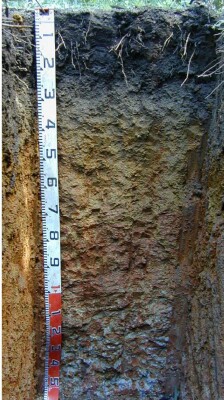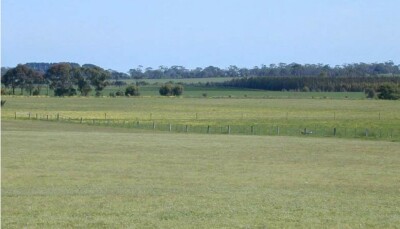| A1 | 0-20 cm | Very dark greyish brown (10YR3/2) fine sandy clay loam; weak polyhedral structure (10-20 mm) parting to weak granular structure (2-5 mm); very weak consistence when moderately moist; many medium roots; clear and smooth transition to: |  |
| A2 | 20-35 cm | Dark yellowish brown (10YR4/4) fine sandy clay loam; weak polyhedral structure (10-20 mm) parting to weak granular (2-5 mm); very weak consistence when moist; very many medium ferruginous nodules; few very fine roots; abrupt and smooth transition to: |
 | Subsoil |  |
| B21 | 35-65 cm | Yellowish brown (10YR5/7) with few medium faint yellowsh red (5YR5/8) mottles, light medium clay; moderate polyhedral structure (20-50 mm) parting to moderate granular structure (5-10 mm); weak consistence when moist; few medium ferruginous nodules; common very fine macropores; areal porosity 0.3%; few very fine roots; diffuse and smooth transition to: |
| B22 | 65-110 cm | Brownish yellow (10YR6/6) with many very coarse distinct red (2.5YR4/6) mottles, light medium clay; moderate polyhedral structure (20-50 mm) parting to moderate granular structure (5-10 mm); weak consistence when moist; few medium ferruginous nodules; common fine macropores; areal porosity 0.4%; few very fine roots; gradual and smooth transition to: |
| B23 | 110-150 cm | Red (10YR7/1) with many very coarse red (2.5YR5/6) mottles, medium clay; strong subangular blocky structure (20-50 mm) parting to strong polyhedral structure (10-20 mm); weak consistence when moist; very few coarse ferruginous nodules; few fine macropores; areal porosity 0.03%; few very fine roots. |
 | 150-250 cm | Similar to above. |
 | 250-350 cm | Heavy clay and weathered basalt rock (60-200 mm). No live roots observed but some old remnant roots were observed between 300-350 cm. |
 | 350-420 cm | More rock than above, still some soil between rocks, no roots observed. |




